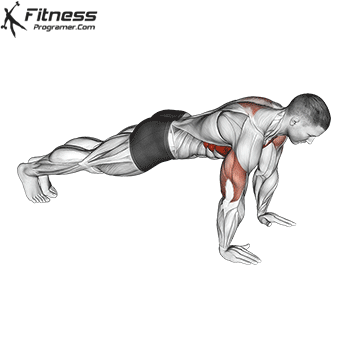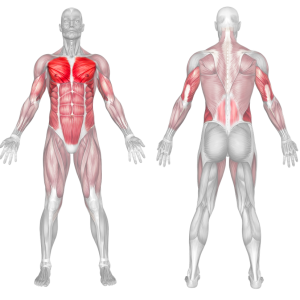Push-Up Plus Overview
The Push-Up Plus is a push-up variation that emphasizes scapula protraction at the peak of the movement. This enhanced range of motion specifically targets the serratus anterior, situated on the sides of your rib cage. Exercise is widely utilized in physical therapy, athletic training, and general fitness routines to enhance shoulder stability and prevent injuries.
How to Perform the Push-Up Plus

- Starting Position:
- Begin in a high plank position, with your hands placed shoulder-width apart and directly under your shoulders.
- Keep your body in a straight line from head to heels, engaging your core and glutes.
- Lowering Phase:
- Slowly lower your chest towards the floor by bending your elbows.
- Maintain a controlled motion, keeping your elbows at a 45-degree angle to your torso.
- Pushing Up:
- Push yourself back up to the starting plank position.
- Scapular Protraction:
- Once at the top, extend your arms slightly further by rounding your upper back and pushing your shoulder blades away from each other.
- Hold for a second to feel the engagement in your serratus anterior.
- Reset:
- Return to the neutral plank position and repeat.
Tips for Proper Form
- Maintain Alignment: Avoid letting your hips sag or pike up during the movement.
- Controlled Movement: Focus on a slow and controlled tempo to maximize muscle activation.
- Engage Your Core: Keep your core tight to prevent excessive arching in your lower back.
- Breathing: Exhale as you push up and protract your scapula; inhale as you lower down.
Common Mistakes
- Skipping the Protraction: Failing to add the scapular protraction negates the primary benefit of the exercise.
- Sagging Hips: This compromises the integrity of your plank and increases the risk of lower back strain.
- Elbow Flare: Allowing your elbows to flare out excessively can stress the shoulders.
1. Improves Shoulder Stability
- The serratus anterior, activated during the “plus” portion of the movement, helps stabilize the scapula (shoulder blade). This reduces the risk of shoulder injuries and improves overall shoulder health.
2. Strengthens the Serratus Anterior
- Weakness in the serratus anterior can lead to poor posture, winged scapula, and shoulder dysfunction. The Push-Up Plus specifically targets this muscle, promoting proper shoulder mechanics.
3. Enhances Core Strength
- Like standard push-ups, this variation engages the core muscles to maintain proper alignment during the movement. The added scapular protraction increases core involvement.
4. Improves Upper Body Strength
- It still targets the chest, triceps, and anterior deltoids, making it an effective compound exercise for building upper body strength.
5. Aids in Rehabilitation
- Physical therapists often recommend this exercise for individuals recovering from shoulder injuries or surgeries. It gently strengthens the shoulder girdle without excessive strain.
6. Improves Functional Movement
- By promoting a strong and stable shoulder girdle, the Push-Up Plus enhances performance in daily activities and athletic movements that require pushing or overhead motions.
7. Corrects Posture
- Strengthening the serratus anterior and improving scapular mechanics can help counteract forward shoulder posture and improve overall alignment.
8. Low Equipment Requirement
- The Push-Up Plus can be performed anywhere with just body weight, making it a convenient and accessible exercise.
How to Incorporate Into Your Routine
- Warm-Up Activation: Use the Push-Up Plus as part of your warm-up to activate the serratus anterior and prepare your shoulders.
- Strength Work: Include 3 sets of 10–15 reps in your upper-body workout for added shoulder stability.
- Rehabilitation: Perform with a modified version (e.g., on knees) under the guidance of a physical therapist for shoulder rehab.
- Progressions: Pair with other push-up variations, such as incline push-ups or weighted push-ups, for a comprehensive strength routine.
Push-up Plus Muscles Worked

